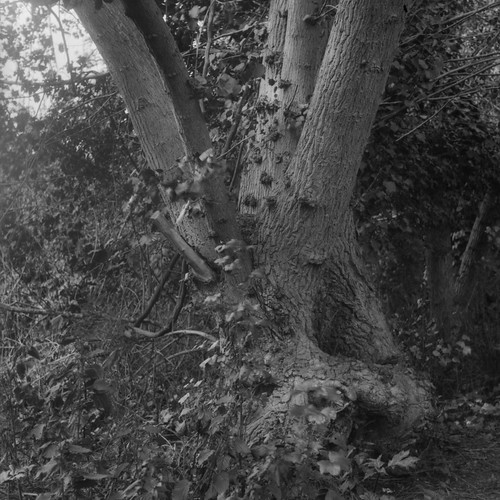 |
| Rolleiflex 4x4 with Kodak High Resolution Aerial Duplicating Film |
Although I have been rating the High Resolution Aerial Duplicating Film at an exposure index of 2, I did attempt a couple of shots hand-held. Given the brightness of the sunlight mid-afternoon in July, this was just possible - the shot below was taken hand-held wide open (f3.5) at 1/15th; the reason for doing this was that the tripod I was using would not give me a high enough angle, and to help steady the camera I did brace myself for the shot against some convenient street furniture, and partly, I suppose, just to show that it was possible to shoot 2 ISO hand-held. (Most of the other images on this post were shot stopped down and exposed for a few seconds with a tripod in contrast to this).
As the High Resolution Aerial Duplicating Film is blue sensitive - like photographic paper - in sunny weather with blue skies (or blue skies and brightly-lit clouds, as I had last summer's 127 Day), these tend to be overexposed and almost featureless. In the image above, the fact that the camera was pointing upwards into a very deep blue sky with a bright foreground negates this somewhat. Other shots, like that immediately below show this difficulty quite acutely; most of the photographs I took on the day were framed to avoid including much or any sky in the image.
Having used the High Resolution Aerial Duplicating Film a fair bit more in recent months, I feel I've begun to understand how to handle it to get the best pictorial results (a purpose of which the film is not intended for). When I was first testing the film, I found it hard to control the contrast when developing the film with conventional film developers, and, at the time, I felt it was best suited to overcast conditions in order to achieve a good range of tones - taking photographs in bright sun seemed to produce negatives with blown highlights and little shadow detail, even when using Rodinal, which I thought would be ideal for the film at high dilutions. Since I've started using the film again more recently, I've been using Ilford Multigrade print developer, at quite high dilutions, with better results. Although I framed most of the shots I took on the day to avoid including too much sky in the frame for reasons outlined above, a number of shots did have patches of sunlight amid shadows, particularly those surrounded by trees and foliage, but these highlights aren't completely devoid of detail, which I would have feared would be the case previously.
The rolls I shot on 127 Day were tray developed by inspection under safelights using the 'see-saw' method in Ilford Multigrade paper developer diluted to around 1+50 (this wasn't very exact - I had already developed a number of paper negatives and sheets of ortho film in the developer in the same session, which I had diluted at about 1+25, and, before developing the Aerial Duplicating Film, I added more water to dilute it still further). The high dilution seems to affect development time more than contrast, but this does have the effect of making development easier by slowing it down; gentle agitation was provided by the slow see-saw motion of passing the film in and out of the tray of developer until the negatives looked dense enough. As the film itself is pretty transparent, or, perhaps more precisely, translucent, before fixing, it can be held up against the safelights to examine the development fairly closely.












No comments:
Post a Comment